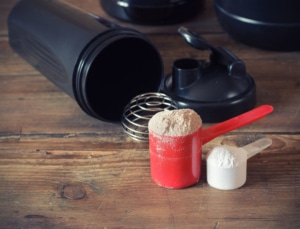Simple Advice to Guys Who Want To Build Muscle
October 8, 2019
You’ve dumped gobs of money into supplements, read 1,047 articles, and viewed countless videos in your muscle-building quest. Heck, you train five or six hours per week.
Still, it feels like you’re no closer to building lean muscle despite all the time, money, and most of all, effort, that you’ve invested.
You think:
“What is wrong with me?”
“I must not know something. There must be some muscle-building secret I’m missing.”
I remember asking the same questions and struggling for years on muscle-building.
Well, after ten years of coaching, and helping thousands of folks transform their bodies, the answer to “how to build muscle when nothing seems to work” has become crystal clear.
And no, I’m not giving you a steroid cycle.
Before going any further, grab a copy of your chiseled muscle cheatsheet. This step-by-step guide gives you everything you need to know to add 10-15 pounds of pure muscle.
Muscle-building comes down to four factors.
1. Stimulus, aka training.
2. Fuel: Having enough calories and protein to build lean muscle.
3. Recovery: Sleep, stress management, and quality food.
4. Consistency: You need to focus on ONLY building muscle for months at a time, not weeks with a bunch of mini cuts, especially as you’re just getting started.
Here’s what you need to focus on to build lean muscle.
Posted by Bach Performance on Monday, September 16, 2019
Here’s a bigger breakdown into each of the four.
Muscle-Building Stimulus/Training:
You can build muscle training three, four, or even five days per week. I find three days per week to be the minimum effective dose (MED). Four and five day routines can work, but they’ll only be optimal when you can stick to them consistently for months at a time.
Either way, here’s what you need to consider. While you may get a boost training more often, you can reach a point of diminishing returns. Adding a fourth workout per week won’t necessarily add up to 25% more progress…but it may add to more stress to the rest of your busy week and aggravation of overuse injuries, particularly if you’re already busy and stressed.
When it comes to implementing your muscle-building training program, the key to success is progressive tension overload in a few key lifts.
Pick one program, do it to completion, and move to the next one. Pick a few key lifts, stick with them for months, and get stronger over time. If you’re slammed and/or overwhelmed with the endless amount of information on the market, grab your spot in Minimalist Muscle Monthly and get a new program sent to you each month.
Muscle-Building Fuel:
If you want to build muscle, you must commit to eating at a caloric surplus for a 12-week block, even in the face of gaining body fat. The idea of losing fat and building muscle at the same time seems great. But it’s a pipe dream for everyone except beginners, steroid users, or the ultra-disciplined with no life outside the gym.
It’s far better to commit to building muscle, knowing the bodyfat you gain along the way will come off easily later. But you have to commit, not cycle calories every ten days because you’ve lost a vein.
Enough ranting, here’s what you should do with your muscle-building diet.
Take your weight in pounds and multiply by 20. That’s how many calories you’ll eat (and track) each day.
Take your body weight in pounds and eat one gram of protein per one pound of bodyweight. Research has consistently shown /0.82g/1lb -1g/1lb bodyweight to be ideal for body composition.
 If you have remaining calories, let your personal preference determine where your calories come from. But as long as you hit your protein and fat numbers, you’re good to go. Here are my top protein shake recipes to get the ball rolling.
If you have remaining calories, let your personal preference determine where your calories come from. But as long as you hit your protein and fat numbers, you’re good to go. Here are my top protein shake recipes to get the ball rolling.
After two or three weeks, increase calories by 200 (by eating a banana and shake, for example) if you’re not adding weight. If you’re starting to gain slowly, stay the course.
Remember, building muscle is not complicated; it’s really quite simple. The hard part is committing to the process and staying the course.
Muscle-Building Recovery:
If you’re like most lifters, you train plenty. The missing component is likely your recovery, which stems from poor nutrition, too much stress, and most of all, lack of sleep.
You need 7-9 hours of sleep to maximize recovery from your muscle-building workouts.
Sleep improves every physiological function your body performs.
Sleep improves your memory and the consolidation of information.
Sleep helps clear metabolic waste, boosting your recovery and improving brain health.
Sleep improves your body’s ability to regulate insulin and as a result, how well your body uses the calories you eat to build muscle and lose fat.
Sleep improves testosterone and growth hormone levels while reducing fat-gaining, muscle zapping cortisol.
Sleep improves killer t-cell counts, which hunt and kill cancerous cells in your body.
In other words, If you want to look better, be smarter, live longer, and maximize your hard work in the gym and boardroom, sleeping 7-9 hours must be a priority.
Here’s a step-by-step checklist to better sleep.
I hate to beg, but I’m going to take one on the chin and do this anyway.
 Take your sleep seriously.
Take your sleep seriously.
It’s the best thing you can do for your health and longevity. I understand how you may feel “guilty” to not be running full throttle while hyped up on coffee and nootropics. But skipping on sleep is like skipping on investing in your retirement because you want to go big at the bars every weekend.
You won’t always be perfect, especially if you have young kids. That’s okay. But demand better effort in improving your sleep, you’ll be blown away at the progress you make across the board.
Consistency:
The biggest mistake lifters make when trying to build muscle is jumping back and forth between cutting and bulking.
Save for a few elite folks, you should focus on ONLY building muscle for months at a time, not weeks with a bunch of mini cuts.
As my colleague Bryan Krahn says, building muscle requires a calendar approach, not a stopwatch. You need months of focused work, not weeks and constantly second guessing your diet every time you lose an ounce of vascularity.
For context, please take a look at this quick chart from muscle building researcher Lyle McDonald.

These are amounts of muscle you can EXPECT to gain if you’ve nailed training, diet, and recovery consistently. The majority of people NEVER get all these factors working long enough to actually make significant progress.
Now, context is important. If you’re nailing everything so far, it seems “slow” to only gain 2-3 pounds in a month. You’d be tempted to say this plan isn’t working, and maybe tempted to change programs.
But…
If you were able to add 15-25 pounds of physique-altering muscle in a year or so, you’d be ecstatic and radically transform your body.
This is the power of consistency. When it comes to building muscle, the process really is simple, but it takes time, sacrifice, and patience.
Those who are willing to embrace this simple truth will be richly rewarded with heaps of health and muscle. Those who don’t are making a decision to stay stuck in the world of program hopping, wasting time, and feeling overwhelmed.
So,what’s the best way to achieve gains rather than staying stuck in a cycle of frustrations?
Focus on a structured and proven plan that walks you through every step along the way. This plan provides the nutritional guidance, meal suggestions, and adjustments you need to keep you gaining muscle while keeping your fat gain to a minimum.
It’s a plan constructed with expert advice from experienced coaches who make the strategic adjustments you need to avoid plateaus and continue gaining muscle.
So, where can you find such a plan?
The Minimalist Muscle Blitz is the golden ticket for achieving your dream physique simply, efficiently, without wasting time and without spending a minute longer than necessary in the gym or kitchen.
Simply head here and grab your program.








